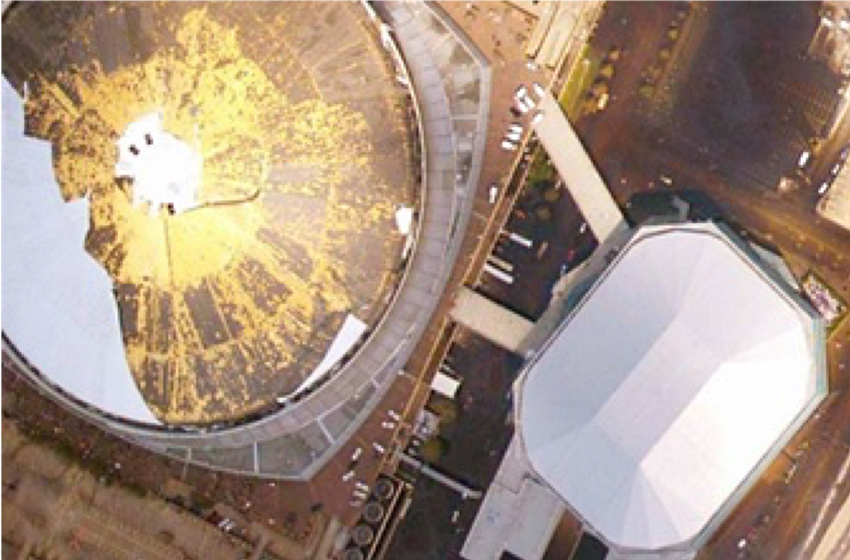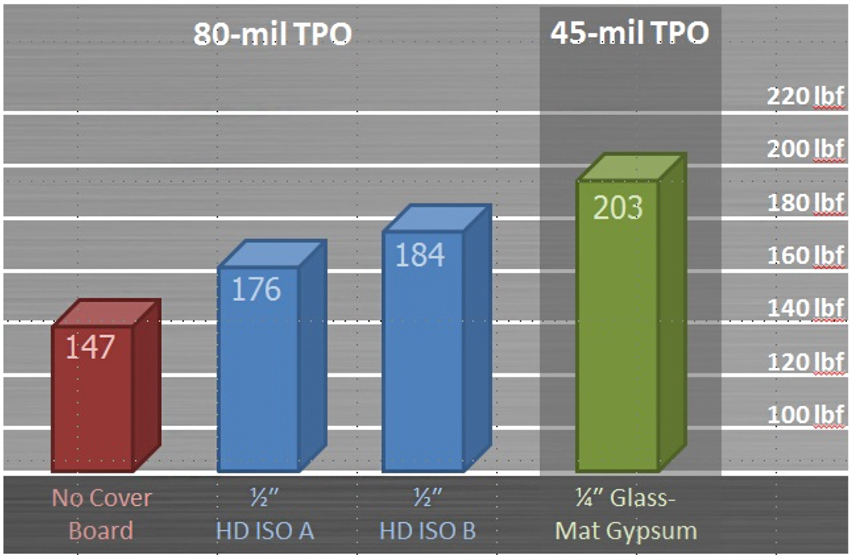Selecting Rigid Cover Boards in Commercial Roofing Systems
Moisture
According to a 2016 survey of roofing consultants, moisture ranked second only to puncture in destructive events that negatively impact the lifespan of a commercial roof assembly. Of course, puncture and moisture can go together since a punctured membrane often leads to a costly moisture issue. Essentially, there are three potential sources of moisture intrusion in a roofing system. First, it can be introduced during construction. Since roof construction is completed outdoors and the weather conditions can’t be controlled, a contractor may need to work under damp conditions to satisfy construction schedules, or to protect the building’s interior. In these instances, rain and dew may become trapped and retained in roofing materials. Second is a roof leak, whether during construction or after it is complete. Even the smallest penetration in a roof membrane allows water to enter the roof assembly. The third source is vapor drive. Roofing products get wet not only from the outside (i.e., from rain and leaks in the membrane) but also from moisture originating inside the building. When high-humidity indoor air meets the cooler underside of the roof membrane, the water vapor can reach the dew point and condense into liquid water.
When water does enter a roof assembly, it can adversely affect the performance of the components: insulation can lose its R-value, roof boards can lose their strength, fasteners can corrode, and even plywood and oriented strand board (OSB) can warp, delaminate, and rot. Wood fiber board that is exposed to condensation over time can even turn into wet pulp, resembling oatmeal. By contrast, products that have the ability to hold up to water intrusion can survive and continue to perform. A good indicator of a cover board’s ability to withstand water is the total water absorption test. This can be determined following the procedures of ASTM C473-15, which is a standard 2-hour soak test with results typically calculated as a percentage weight gain. Translating that into volume for a 4-by-4-foot roof board, test results show that a glass-mat gypsum board absorbs 0.1 gallon of water, while a gypsum fiber board absorbs nearly 2.0 gallons. In order to minimize the amount of water absorption in roof boards and contribute to a more resilient roof, it is recommended to specify roof boards that have been tested not to exceed 5 percent maximum total water absorption by weight.
Moisture can also affect the flexural strength of some of the more commonly used rigid cover boards. Flexural strength is a strong indicator of the board’s ability to withstand wind uplift. When different types of boards are tested for this trait, moisture has a detrimental effect on each type of cover board but to varying degrees. ASTM C1177 is the test to determine flexural strength when different roof boards are exposed to moisture. This testing has shown that the leading glass mat gypsum board maintains more of its strength and lasts longer than other alternatives before reaching the saturation point. It is worth remembering that all tested boards lose strength when wet so avoiding exposure to moisture before, during, and after installation is important. Note too that products with low vapor permeability will dry out slower than products with high vapor permeability.

Independent test results illustrate the effect moisture has on the flexural strength of some of the more commonly used rigid cover boards. Testing was conducted by Trinity Laboratory, Columbia, South Carolina, in 2016/2017 in accordance with ASTM C1177.
Wind Uplift
Wind uplift resistance is defined as the ability of the roofing assembly to resist blow-off and minimize property damage. Wind-generated forces that are trying to lift the roof off a building can amount to the equivalent of hundreds of pounds per square foot (psf). FM guidelines are often used to address wind uplift and design roof assemblies. While wind uplift is an important consideration for almost all projects, it is particularly crucial for buildings where wind conditions are a common issue, such as coastal regions and hurricane-prone areas.
Cover boards can contribute to wind uplift durability in a variety of roofing system configurations. For fully adhered membranes, where the membrane is held down by a continuous coating of adhesive, wind performance relies on the strength of the substrate. That means if the membrane is bonded to a fragile, low-density insulation layer, uplift forces can literally pull the insulation apart. A strong, rigid cover board installed between the membrane and the insulation can prevent this from happening. For mechanically fastened membranes, cover boards can also enhance durability. In these cases, the plates and fasteners transfer the uplift forces exerted on the membrane down to the structural deck below. To address this and protect the roof, a suitable cover board positioned under the membrane will hold the fasteners while maintaining compression and strength.
A notable example of loss due to wind uplift was evidenced when Hurricane Katrina struck New Orleans in August 2005. The well-documented Superdome, which did not include a cover board in the roof assembly, suffered a complete loss of the roof. Meanwhile, the New Orleans Arena located right across the street used a coated glass mat gypsum cover board and did not experience any noticeable loss. While the two can’t be compared as equals (both were roughly the same age, but the Superdome had a much larger roof surface, at a different pitch and height), the contrast in the level of damage is so stark, it stands as a good representation of how a gypsum cover board can enhance a roof assembly’s wind uplift performance.

During Hurricane Katrina in 2005, the Superdome, shown on the left, had a roof system without a cover board that was severely damaged. Across the street, the New Orleans Arena roof, which included a glass-mat gypsum cover board, remained intact.
Hail and Puncture
As noted, surveyed roofing consultants rank punctures as the most frequent event that reduces a roof’s lifespan. Both high-speed events (hail, flying debris, etc.) and low-impact puncture events (foot traffic, dropped tools, etc.) can understandably lead to multiple issues, including water intrusion, building down time, decreased R-value, reduction in wind resistance, and of course costly repairs.
Related to hail, glass mat gypsum cover board that is only 1⁄4 inch thick required a 2-inch hail stone in testing to fracture the cover board. Note that fleeceback membranes (i.e., single-ply membranes with a fibrous coating on the underside) were found to help mitigate the risk of hail damage, especially when used with a gypsum-based cover board. The significance of this testing lies in the fact that the frequency of hail storms that includes stones less than 2 inches is dramatically higher than storms with stones 2 inches or larger. Thus, choosing a cover board that can withstand large hail stones provides a great advantage.
Independent tests have also been conducted to measure various roof assemblies’ resistance to puncture by simulating heavy tools being dropped on the roof and by simulated airborne debris. These test results indicated that 1⁄2-inch HD ISO provided only marginal improvement over an assembly with no cover board. Meanwhile, 1⁄4-inch glass mat gypsum board has been found in testing to provide more than three times the puncture resistance compared to no cover board at all.
Foot Traffic
Although damage from hail impact is obvious, the damage caused by foot traffic is less immediately noticeable but can be even more pervasive. Foot traffic on adhered roof systems stresses the adhesive bond between the membrane and cover board as the materials deflect under load. On mechanically attached systems, the fasteners can be unduly stressed and loosened. On any system, stepping on debris on top of the membrane can cause a puncture. While a building is under construction, multiple trades end up using the roof deck as a staging and storage area. Foot traffic, wheel barrows, and equipment carts all generate loads that compress unprotected insulation and threaten the membrane with stretching and punctures. Foot traffic damage can occur first during installation of the roof itself, then from installation of rooftop items such as HVAC equipment and antenna systems, among others. Post-construction, routine maintenance of rooftop equipment continues the stress; this is why some roofing system warranties place a limit on the amount of rooftop traffic that can be tolerated.
Building owners rarely realize how much foot traffic their roofs are exposed to, but national surveys show that 68 percent of low-slope systems host HVAC and other equipment. The maintenance, emergency servicing, and inspection visits to all of that rooftop equipment create foot traffic by individuals who can be unaware of the damage caused by their boots and tools. Personnel with tool boxes and equipment also increase the likelihood of impact damage to the insulation caused by foot traffic. Reinforced pathways are often designated for maintenance personnel, but they are only effective if they are actually used instead of being bypassed for a shorter route across the roof.
Different roofing membranes are more durable than others based on their thickness. For example, an 80-mil TPO roofing membrane is reasonably expected to hold up better than a 45-mil TPO membrane. However, the cost difference between the two thicknesses is noticeable, and the heavier membrane brings different installation needs. A proven alternative is to use a glass mat gypsum cover board, which will allow a 45-mil TPO membrane to perform as well as an 80-mil TPO membrane alone in terms of puncture resistance, the type that results from foot traffic. Testing conducted by Intertek in York, Pennsylvania, in accordance with ASTM D4833 determined that with a thinner board and membrane, the tested glass-mat gypsum assembly delivered more puncture resistance at a lower overall cost.

A coated glass mat gypsum cover board with a 45-mil TPO membrane was tested and shown to provide more puncture resistance at a lower overall cost than using 80-mil TPO with other cover board options. Testing was conducted by Intertek in York, Pennsylvania, and concluded on January 15, 2016 in accordance with ASTM D4833.









